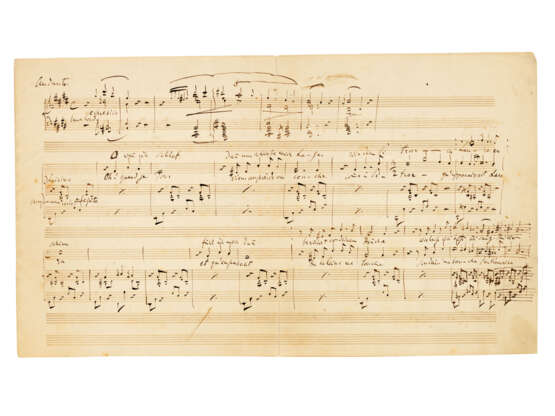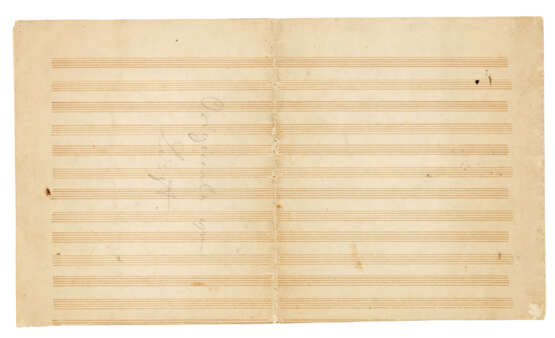ID 381239
Lot 32 | Franz Liszt (1811-1886)
Estimate value
£ 10 000 – 15 000
Two pages, 190 x 330mm, bifolium, integral blank, the paper cut down from a larger sheet, ruled with 12 staves per page, scored for voice and piano, three systems of three staves per page except for the piano introduction on two staves, 55 bars in total, pencil attribution in German in a later hand on the verso of the integral blank (worn and split along central vertical fold and at bifolium hinge).
Text by Victor Hugo, in French, with a German translation accompanied in places by a double vocal line.
Provenance: From the same ownership as lot 33, an autograph draft for the song ‘Ich möchte hingehn’: corresponding creases indicate that the two were stored folded together for some time.
‘Oh! quand je dors’: a manuscript for one of Liszt’s most famous songs, apparently a compositional draft from the period in which the composer gathered together – and revised – earlier works for publication by Schlesinger in the Gesammelte Lieder. Liszt wrote two versions of his celebrated song ‘Oh! quand je dors’, a setting of an 1840 poem by Victor Hugo. The first was conceived in 1842, as he first started to explore setting texts in languages other than German, and was one of six Hugo poems he selected for the second Buch der Lieder published in 1844 by Schlesinger in Paris; the second was first composed in 1849 and published in 1859 by Schlesinger in Berlin. The present manuscript resembles the song as it was published in 1859 more closely but neither the music nor the text correspond fully to either version: as a compositional draft it exemplifies the way in which Liszt worked on his Lieder, continually reworking them across the years until they became, essentially, new works, often unrecognisable from the original versions (for more on this process see Rena C. Mueller, ‘The Lieder of Franz Liszt’, The Cambridge Companion to the Lied (2004), pp. 168-84). After entering into an agreement with Schlesinger in the mid-1850s to prepare a collected edition of his songs – published as the Gesammelte Lieder between 1855 and 1859 – Liszt revisited earlier songs such as ‘Oh! quand je dors’, many of which originated in the 1840s; what began as fair copies soon became compositional drafts, as he started to revise them as he progressed. During this process, between 1856 and 1859, Liszt used paper originally meant for orchestral music, cut down or torn from larger sheets, as here. He also undertook his own translations of Hugo’s French text into German at this time – having found the 1844 version wanting – and the present manuscript bears witness to his efforts to this end, before the task was eventually handed over to Peter Cornelius for the final edition of 1859.
Christie's is grateful to Professor Rena Charnin Mueller for her advice on the present lot.
| Address of auction |
CHRISTIE'S 8 King Street, St. James's SW1Y 6QT London United Kingdom | |
|---|---|---|
| Preview |
| |
| Phone | +44 (0)20 7839 9060 | |
| Buyer Premium | see on Website | |
| Conditions of purchase | Conditions of purchase |





